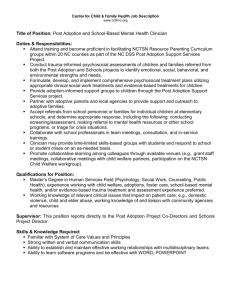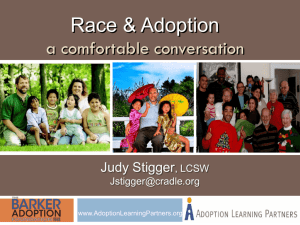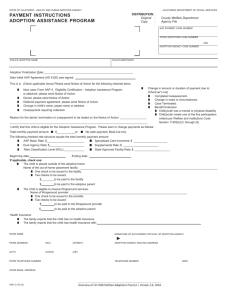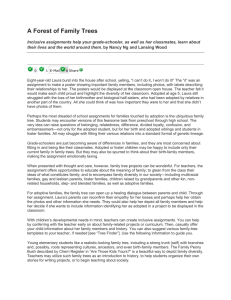The Important Contributions of Adoptive Families
advertisement
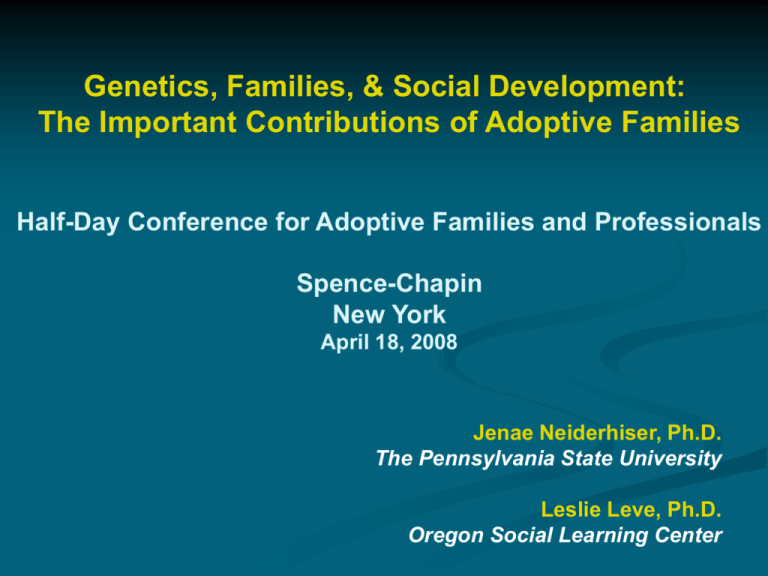
Genetics, Families, & Social Development: The Important Contributions of Adoptive Families Half-Day Conference for Adoptive Families and Professionals Spence-Chapin New York April 18, 2008 Jenae Neiderhiser, Ph.D. The Pennsylvania State University Leslie Leve, Ph.D. Oregon Social Learning Center Workshop Outline I. Overview of Genetics II. Description of the Early Growth & Development Study (and family of studies) III. Early Results from EGDS IV. Implications for Prevention and Services for Adoptive Families I. Overview of Genetics Developmental Behavior Genetics Behavior genetics: Exploration of the potential influence of genes and experience upon a behavior Focus: Individual differences & the similarity (covariance) of relatives Research Strategies: Twin studies, Family studies, & Adoption studies (and combinations) Individual Differences: Concerned with differences among individuals within a population e.g. How does antisocial behavior differ in a population of teenagers? Group Differences: Concerned with differences between groups within a population e.g. How do teenage boys and girls differ for antisocial behavior? Estimating genetic & environmental influences Examine family members who differ in degree of genetic relatedness identical twins, fraternal twins, parent-biological child, adoptive parent-adopted child Compare similarity in family members (correlations) Genetic influences Indicated by increased similarity for increased genetic relatedness MZ twins > DZ twins > adopted siblings Shared environmental influences Indicated by within-family similarity ANY similarity in adopted siblings or between adopted children & their adoptive parents Nonshared environmental influences Indicated by differences in family members ANY differences between MZ twins Covariance of Relatives Identical Twins Fraternal Twins Full Siblings Adoptive Siblings Birth Parent-Child Adoptive Parent-Child G 1.0 .50 .50 0 .50 0 Es 1.0 1.0 1.0 1.0 0 1.0 En 0 0 0 0 0 0 Heritability: Proportion of total variance that can be explained by genetic differences in individuals in that population Environmentality: Proportion of total variance that can be explained by nongenetic (environmental) differences in individuals in that population Shared environment – all nongenetic influences that make family members similar to one another Nonshared environment – all nongenetic influences that make family members different from one another Important Points about genetic and environmental influences Heritability does not equal immutability – it can be changed and modified by the environment Heritability can, and does, change over time There is a large amount of variation that is not due to genetic factors “Genetic influence” on a phenotype does not imply: -the environment is unimportant -genetic determinism, or even a close relationship between genes & behavior Environmental influences are all nongenetic influences that contribute to individual differences May include: prenatal effects, environmental influences on DNA, traditional environmental factors (parenting, neighborhood, SES, etc.) Patterns of Genetic & Environmental Influences Wide range of behaviors have been examined across the lifespan Physical characteristics (height/weight) Personality & temperament Mental health & psychopathology Social relationships & behavior Sample Twin Correlations 1 0.8 0.6 0.4 0.2 0 Height Weight MZ DZ Genetic and Environmental Influences on Psychological Traits Specific Religion Religiousness A C E Major Depression IQ @ 18 yrs IQ @ 10 yrs IQ @ 5 yrs Extraversion 0% 10% 20% 30% 40% 50% 60% 70% 80% 90% 100% Genetic and Environmental Influences on Interpersonal Relationships Parental Positivity Parental Negativity A C E Parental Monitoring Sibling Conflict Marital Conflict about Children Peer Group Delinquency 0% 10% 20% 30% 40% 50% 60% 70% 80% 90% 100% General patterns of genetic & environmental influences on interpersonal relationships most salient for children & adolescents Parenting Warmth/Support & Conflict/Negativity Tend to show genetic influences Monitoring & Control Tend to show shared environmental influences Sibling relationships Mostly reciprocal in nature due to shared environmental influences Peer relationships Vary by construct, generally due to genetic & shared environmental influences How can we understand genetic influences on “environmental” measures and interpersonal relationships? GP Parent Temperament Gc Parenting Behavior and/or Parent-Child Relationship .50 Passive Genotype-Environment Correlation How can we understand genetic influences on “environmental” measures and interpersonal relationships? parent influences Child behavioral CHARACTERISTICS Parental CONFLICT/NEG child evokes FAMILY EFFECTS CHILD EFFECTS GC Evocative Genotype-Environment Correlations Why do we care? Direction of effects: Child to parent (evocative rGE) Parent to child (passive rGE or E) What are the mechanisms of the environment’s influence on child outcomes? Mechanisms of Parenting Gp Passive GE Correlation Parent’s characteristics Contextual factors Parenting behavior Evocative GE Correlation Gc Child’s characteristics Nonshared Environment in Adolescent Development Project (NEAD) Reiss, Hetherington, Plomin (PIs of T1 & T2), Neiderhiser (PI T3) Time 2 Assessment N=384 families Age range 13-21 2 family types: nondivorced & step families 5 sibling types: MZ & DZ twins, full, half, step Twin/Offspring Study in Sweden 909 pairs of twin families 1 adolescent child/family (1122 yrs) 350 pairs of twin fathers (128 MZ; 183 DZ) 559 pairs of twin mothers (254 MZ; 285 DZ) Cousin pairs w/in 4 years of age Same sex cousin pairs (49% boys) Spouse/other parent Cohabitating for at least 5 years Over 90% of spouses are biological parent of child NEAD and TOSS Designs TOSS NEAD 1.0=MZ twin parents; .50=DZ twin parents Mom Dad Spouse 1 Child 1 Twin Parent 1 Twin Parent 2 Spouse 2 Child 2 Child of Twin 1 Child of Twin 2 1.0=MZ twins; .50=DZ twins & full siblings; .25=half siblings; 0=step siblings .25=children of MZ twin parents; .125=children of DZ twin parents Parenting: GE Correlation Mothering Positivity - NEAD Passive & Evocative GE Correlation Positivity - TOSS Negativity - NEAD Passive & Evocative GE Correlation G Es En Negativity - TOSS Fathering Positivity - NEAD Mostly Evocative GE Correlation Positivity - TOSS Negativity - NEAD Evocative & Passive GE Correlation Negativity - TOSS 0% 20% 40% 60% 80% 100% Evidence for Evocative GE Correlation: Adopted Adolescents and Adoptive Parents Adoptive Parents Marital Warmth Adoptive Mother -.46* -.05 Mother’s Discipline .48* Psychiatric Disorders .31* .44* Antisocial/ Hostile Beh. Birth Parents Adopted Child from Ge et al., 1996 Average negative control by adoptive parents of children whose birth mothers were antisocial (at risk) or not 32 30 28 at-risk not at-risk 26 24 22 20 7 9 10 11 Age (in years) from O’Connor et al., 1998 12 Gene-environment Interplay Two types Genotype – environment correlation Genotype x environment interaction Genotype x environment interaction BOTH genetic factors & environmental factors (typically risk) are required for a specific outcome For example… Interaction of genetic influence and family characteristics in childhood aggression (Cadoret, 1995) Antisocial personality in birth parent No antisocial personality in birth parent Favorable Unfavorable Adverse Adoptive Home Environment Factors (adoptive parent marital or legal problems or psychiatric d/o) Thanks to the research teams that make this work possible NEAD Robert Plomin (IoP) David Reiss (GWU) E. Mavis Hetherington (UVA) Mark Feinberg (PSU) Erica Spotts (NIA) Dean Hamer (NCI) Jody Ganiban (GWU) Rich Rende (Brown) many other students & postdocs R01s MH43373, MH48825, & MH59014 & the William T. Grant Foundation TOSS Paul Lichtenstein (KI) David Reiss (GWU) Nancy Pedersen (KI) Jody Ganiban (GWU) Erica Spotts (NIA) Suzanne Haddad (GWU) Jurgita Naruyste (KI) Jennifer Ulbricht (GWU) Lennart Martinnson (KI) Elias Ericksson (Göteborgs Universitet) R01MH54601 & Riksbankens Jubieleumsfond (DNA collection & genotyping) II. Early Growth and Development Study 560 domestic adoption placements to nonrelative families (360 in EGDS-Toddler and 200 in EGDS-Phase 2) Adoption occurred within 3 mo. postpartum Infant free of major medical problems 3 major assessments for birth parents and 6 major assessments for adoptive families spanning infancy through 1st grade (EGDS-School) Multimethod, multiagent approach Early Growth and Development Study 9 mo, 18 mo & 27 mo in-person assessment of adoptive families 3-6 mo & 18 mo inperson assessment for birth parents Multimethod, multiagent approach EGDS study design Yoked Adoption Unit: • Birth mother/birth father, adoptive mother/father, & adopted child BM AM BF AC AF EGDS Family of Studies EGDS-Toddler (PI: Reiss) Sept 2002- Aug 2007 n = 360 yoked adoption units 7 yrs 6 yrs 4½ yrs 36- 48 mo 27 mo 18 mo 9 mo Prenatal Period 3 mo to 6 mo parenting, context, externalizing, internalizing, social competence, birth parent characteristics EGDS-Phase 2 (PI: Neiderhiser) Sept 2007 – May 2012 EGDS-School (PI: Leve) Sept 2007 – July 2012 n = 200 NEW + 360 from EGDS-Toddler n = 360 New: 200 cases, DNA, enhanced measurement of birthparent experiences, prenatal exposures New: Emergent literacy, executive functioning, HPA axis functioning Recruitment locations Three data collection sites Pacific Northwest (Oregon Social Learning Center) Mid-Atlantic (George Washington University) Southwest (University of California, Davis) One new site added for EGDS-Phase 2 Midwest (University of Minnesota) (and PI moved to Penn State) Recruitment Strategy Agency Recruitment Each data collection site identifies “local” agencies Collects data on number and type of placements Identify agency liaison once agency agrees to participate 33 agencies in 10 states participated in EGDS-toddlers 16 agencies participating in EGDS-Phase 2 (13 from EGDS-toddlers, 3 new) Recruitment Strategy Strategy to maximize linked birth parents & adoptive parents Adoptive family recruitment Eligible adoptive families are mailed a letter by agency Includes postage paid postcard to decline contact If no postcard received within 2 weeks of mailing birth mother contact information is requested If birth mother agrees to participate study recruiter contacts adoptive family First assessment – 6 mo telephone interview Recruitment Strategy Birth mother recruitment If no postcard received within 2 weeks of mailing birth mother contact information is requested Birth mother is contacted by study recruiter First assessment – Wave 1 in-person interview, 3-6 months postpartum EGDS Toddlers/School – 360 yoked birth mothers, 517 total (many unyoked) Recruitment Strategy Birth father recruitment Contact information requested from agency after birth mother and adoptive family agree to participate Birth mothers are asked for contact information if agency can not provide this Birth fathers are critical for the study (provide 50% of child’s genes) EGDS Toddlers/School – 105 yoked birth fathers, 147 total (some unyoked) EGDS constructs • Birth parents, adoptive parents, and children • Externalizing, internalizing, social competence • Alcohol & drug use and problems • Temperament • Social context (stress, social support, economic circumstances, partner/marital relations) • Executive functioning and literacy • DNA and salivary cortisol samples • Adoptive parents only • Parenting • Birth parents only • Prenatal exposure to substances, toxins, stress Assessment Telephone Assessments (10-15 minutes) General well-being, short questionnaires Mailed/Web-Based Interviews (1-1.5 hrs) Completed before in-person assessments Cortisol collection mailed after in-person visit In-person Assessments (2-3 hours) In home or convenient other location Computer-administered questions & interview Video-recorded child tasks, parent-child interactions and marital interactions DNA collection Barrier Task – designed to elicit frustration (9 mo – Wave 1) Clean-up Task – designed to see how parent structures task & child compliance 18-month old task (Wave 2) Show video Flower Print Task – designed to examine coparenting (9 mo – Wave 1) Demographics for BPs and APs: EGDS -Toddlers BM BF AM AF 23.83 (13-51) 25.31 (15-45) 36.96 (25-54) 37.89 (26-60) Caucasian African-American 78 11 63 20 93 4 92 5 Hispanic/Latino 4 8 1 1 Multi-ethnic 5 5 2 2 Other 2 4 1 1 Mean age (range) Race (%) Mean education level Annual household income (median) People in home (mean) Tradeschool Tradeschool College College $14k $21k $119k 3.6 3.5 3.7 Demographics (Con’t) Adoptive Parents 1% single 84% AM, 86% AF married 1% divorced/separated 9% remarried 5% AM, 4% AF cohabitating, committed rel. Birth Parents 77% BM, 72% BF single 8% BM, 22% BF married 14% BM, 5% BF divorced/separated 1% BM & BF remarried New Studies & Future Directions EGDS-Phase 2 (PI: Neiderhiser, R01 DA020585) Objectives: (1) Collection of DNA from all members of yoked adoption unit • Birth parents • Adopted child • Adoptive parents (2) Addition of 200 more yoked adoption units EGDS-School: Family Process, Genes, and School Entry (PI: Leve, R01 HD42608-06) Objectives: 1)Examine GxE mechanisms in preschool, school entry, and 1st grade 2) Examine hypothesized social and neuroregulatory mechanisms specific to this developmental period: emergent literacy, HPA axis functioning, & executive functioning Future Directions Emotion regulation within the family Applying for a grant to code the video taped data Emotion regulation within dyads Coparenting Translate interviews Allow recruitment of a Spanish-speaking population Capture changing trends in adoption III. EGDS results related to adoption • Openness • Agency satisfaction and services • How adoption has affected aspects of your life What was the level of openness in the adoption? • 1-7 rating of the level of openness in the adoption very closed closed semiopen moderately open open quite open very open Openness • Most families continue to report a moderate level of openness throughout toddlerhood (periodic phone contact, visits, or mail exchanges) • Openness decreased somewhat over time according to adoptive mothers, adoptive father, birth mothers, and birth fathers. • For example, at 9-months of age, 59% of adoptive mothers rated the adoption as “open” or “very open”. This decreased to 56% at 18-months, and 54% at 27months. How satisfied are adoptive families with the level of openness? • 1-4 rating of the level of satisfaction (very satisfied very dissatisfied in the level of openness in the adoption) • Most families continue to report a high level of satisfaction with the level of openness throughout toddlerhood • Satisfaction also decreased steadily over time according to adoptive mothers, adoptive father, birth mothers, and birth fathers. • For example, at 9-months of age, 69% of adoptive fathers were “very satisfied” with the openness. This decreased to 63% at 18-months, and 53% at 27-months. How would adoptive mothers change openness? 9-months More closed Same More open 18-months 27-months How would adoptive fathers change openness? 9-months More closed Same More open 18-months 27-months What does openness relate to? • Adoptive mother, adoptive fathers, and birth mothers agree very strongly about the level of openness in the adoption, about the amount of contact, and about the amount of knowledge between parties • Higher levels of openness are related to adoptive mothers’ and fathers’ increased satisfaction with the adoption process • Higher levels of openness are related to birth mothers’ and birth fathers’ increased satisfaction with the adoption process and positive adjustment Ge et al., J. of Family Psychology, in press How satisfied are adoptive mothers with the information they have about the birth parents? (very stable; numbers here are at 27-months) Birth Mothers very satisfied fairly satisfied fairly dissatisfied very dissatisfied Birth Fathers How satisfied are adoptive fathers with the information they have about the birth parents? (very stable; numbers here are at 27-months) Birth Mothers very satisfied fairly satisfied fairly dissatisfied very dissatisfied Birth Fathers Why did the adoptive family select their agency? • On average, adoptive families looked at 3-4 agencies before selecting the one they used. The primary deciding factors were: • The agency’s philosophy about adoption, including openness, and the agency mission statement (83%) • The information received about the adoption agency from a packet, website, or meeting (69%) • Other people’s recommendation, word of mouth, or agency reputation (68%) • Geographic location of the agency (53%) • Agency staff (50%) Why did the birth mother select their agency? • On average, birth mothers looked at about 2 agencies before selecting the one they used. The primary deciding factors were: • The agency’s philosophy about adoption, including openness, and the agency mission statement (68%) • The information received about the adoption agency from a packet, website, or meeting (64%) • Services offered, such as counseling, meeting other birth parents, or support group (50%) • Other people’s recommendation, word of mouth, or agency reputation (47%) • Agency staff (45%) Satisfaction (‘very’ or ‘somewhat’) with services • The information agency provided about adoption process (96%) • Education and support services (90%) • Ability to make recommendations for outside services like counseling (89%) • Staff responsiveness to requests (88%) • Skill of the staff (92%) • Policy about openness (98%) • Home study process, including the length of time it took to complete it (95%) • Matching process (95%) • Placement process (94%) • Post placement services (91%) Agency services that were most helpful • The matching/placement process • Educational classes • Orientation workshop • Specific social worker/staff member • Availability and support of agency staff • Counseling • Mediation with birth mother Services sought outside of the agency • Legal services (19%) • Home study from a different agency (7%) • Infant care/parenting classes (4%) • Support group (4%) • Counseling (3%) The most difficult part of the adoption process • Waiting for a child • Coming to the decision to adopt • The adoption process • General adjustment to new child (lack of sleep, siblings) • Coming to terms with infertility issues • Adoption paperwork • Cost • Dealing with a failed adoption(s) Nicest or most important thing someone did during the adoption process • Support from friends and family • Baby shower • The birth parents choosing us to raise their child • Friends and family providing meals • Friends and family babysitting • Friends and family sharing their experiences with adoption How has your child affected your life? (mothers @ 27 months) Marital Relationship Other Children Satisfaction With Life Improved lot Improved slightly No change Slightly worse Lot worse How has your child affected your life? (fathers @ 27 months) Marital Relationship Improved lot Improved slightly No change Slightly worse Lot worse Other Children Satisfaction With Life IV. Implications for Prevention and Services • Most challenging parenting issues • Desired services • Format of services What months have been the most challenging to parent? 60 40 20 0 0 2 4 6 8 10 12 14 16 18 20 22 24 26 Mothers Fathers What do adoptive parents think are the “most challenging issues” as parents (1st year of life) 50 Mothers1st year 40 30 Fathers 1st year 20 10 en c fid Co n m e Ti e nt M ng m lth He a ng ed i Fe ee p 0 Sl # Reporting 60 What do adoptive parents think are the “most challenging issues” as parents (2nd year of life) Mothers1st year Fathers 1st year Mothers 2nd year Fathers 2nd year 50 40 30 20 10 en c fid Co n m e Ti e nt M ng m lth He a ng ed i Fe ee p 0 Sl # Reporting 60 60 50 40 30 20 10 0 Mothers 2nd year en t Te m pe ra m lity ob i M Si bl in gs ip lin e Di sc m s Fathers 2nd year nt ru Ta # Reporting What do adoptive parents think are the “most challenging issues” as parents (2nd year of life) 60 50 40 30 20 10 0 en t Te m pe ra m lity ob i M Si bl in gs ip lin e Di sc m s Mothers1st year Fathers 1st year Mothers 2nd year Fathers 2nd year nt ru Ta # Reporting What do adoptive parents think are the “most challenging issues” as parents (2nd year of life) Desired Adoption-Specific Parenting Services Talking to child about adoption (how/when) Contact with birth parents (how much/how to manage) Transracial and cultural issues (how to educate) Blended families (how to discuss with your children) Stigma/responding to others’ questions Agency services families wished the agency had provided • More/better education about the adoption process • More/better support groups • More parenting education • More staff accessibility • Support groups pre-placement • More support for birth mothers How often wanted some advice about parenting? never rarely sometimes often Mothers almost/all time Fathers Top 3 areas where parenting information would be helpful (mothers @ 27 months) Disciplining Not at all helpful A little Somewhat Helpful Very helpful Managing Toddler Emotions Temper Tantrums Top 3 areas where parenting information would be helpful (fathers @ 27 months) Disciplining Not at all helpful A little Somewhat Helpful Very helpful Managing Toddler Emotions Sleep Issues Other areas where help information and services would be helpful (at least 1/3 of mothers said information would be ‘helpful’ or ‘very helpful’) • Enhancing child’s strengths (46%) • General child development (43%) • Adoption issues (42%) • Child compliance (40%) • Child hitting, biting (39%) • Child whining (38%) • Child temperament (37%) • How to play with child (34%) How would you like to receive parenting resource information? mail doctor/ped website home visit group meeting check-in phone hotline How often would you like services? weekly monthly every other month yearly as needed never Summary • Most adoptive parents, and especially mothers, would like more information about parenting • Areas where information and services are most desired are: discipline and child behavior, general child development, strength building, and adoption • Adoptive families would prefer these services be delivered as an as-needed or monthly basis • Mailed information, information from a doctor or pediatrician, or parenting website are the most desirable formats • 0-2 months, 10-12 months, 18 months, and 24-months are times when parents report the most challenges So where do we go from here? What kinds of services and programs might be beneficial? Key components of ‘evidence-based’ programs for infants, toddlers, and preschoolers • Teach warm and sensitive (but firm and consistent) parenting • Strength-building • Prevention-based • Work within the multiple contexts that families and children interact in (home, school, community) • Include both a child and caregiver components • Include parenting groups for social support • Weekly service delivery • Video-based feedback What about adoptive families? • No evidence-based programs have been evaluated specifically for adoptive families, although there are evidence-based programs for foster parents • Unique needs of adoptive families may include: • generally well-educated and invested in parenting • uncertainties about child’s genetic background • transracial and cultural issues • blended families • interface with birth parents • talking to child about adoption/their background • ?? Task Frustration to Verbal Infant Attention Infant Aversive Response The adoptive family as a protective environment at child age 9-months Adoptive family emotional arousal HI Children in homes with average emotional arousal in the adoptive parents do not attend to frustrating events, even when there is an inherited tendency BP Social Anxiety Birth Mother Externalizing Behavior Adoptive family emotional arousal AVERAGE Infant Aversive Verbal Response The adoptive family as a protective environment at child age 18-months Adoptive family emotional arousal HI Adoptive family Children in homes with average emotional emotional arousal arousal in the adoptive parents do not AVERAGE show aversive responses, even when there is an inherited tendency BP SocialSociability Anxiety Birth Parent LO HI Providing structured guidance reduces genetic risk for externalizing behaviors BEXT1 25.00 20.00 CBCL External WaveB-AM behavior Child externalizing .00 High structured guidance relates to low child externalizing problems, even when inherited risk 1.00 .00 1.00 HI Birth parent Externalizing 15.00 LO Birth parent Externalizing 10.00 5.00 R Sq Linear = 0.016 R Sq Linear = 0.317 0.00 -3.00000 -2.00000 -1.00000 0.00000 1.00000 2.00000 3.00000 Zscore: CUP:Mom->TC Command dur Adoptive mother structured guidance Parenting interventions can impact neuroregulatory functioning Cortisol Value 0.5 0.4 Foster care Foster care Int Comm sample 0.3 0.2 0.1 0 Entry 8-9 Months Post Entry Time Fisher & Bruce (2008) The EGDS Team Jenae Neiderhiser (PSU) Leslie Leve (OSLC) Xiaojia Ge (UMN) David Reiss (GWU, Yale) John Reid (OSLC) Danny Shaw (U Pitt) Laura Scaramella (UNO) Linda Mayes (Yale) Jody Ganiban (GWU) Phil Fisher (OSLC) Rand Conger (UC Davis) Over 30 participating adoption agencies across the US EGDS-toddlers & EGDS-school: R01HD042608 (co-funding by NIDA & OD) EGDS-Phase II: R01DA020585 (co-funding by NIMH & OD) Too many recruiters & interviewers to name Amy Whitesel Cristin McArdle Tracy VanVlack Consultants: Joel Gelernter (Yale) Joan Kaufman (Yale) Steve Petrill (OSU) Steve Suomi (NICHD intramural)
